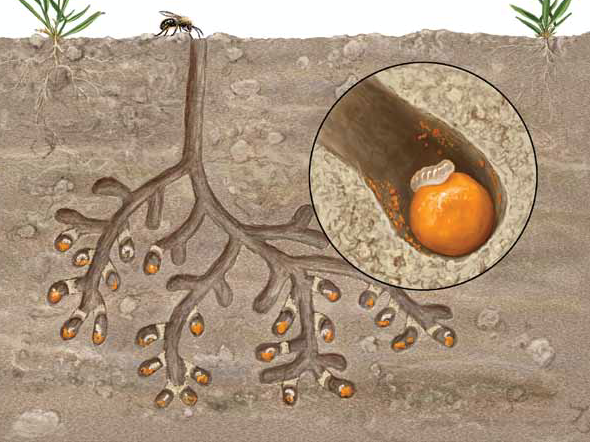Research Project: Evaluating Native Bee Abundance, Diversity and Nesting Preferences in Small-Scale Wildflower Strips and Managed Turf Grass
Many people may be familiar with the terms “miner bees”, “cellophane bees” or “sweat bees”. These ground nesting bees are important pollinators of native plants and 70% of bee species worldwide nest within the ground (Wilson-Rich, 2014). Yet little is known about bee nesting preference (Cope et al, 2019), and which ground soil textures or ground substrates different bee species prefer, though there is evidence that bees will nest in sandy soils and have a preference for bare ground (Cane, 1991; Cane, 2015). As a graduate student in the bee lab, I am very interested in floral resources for bees (planting native wildflower meadows) and whether these meadows can also provide ground nesting habitat for native bees, especially since so many ground nesting bees have limited flight ranges up to a few hundred feet and must have food resources and nesting habitat in close proximity. I am also concerned about whether managed/mown turf grass can provide needed nesting habitat.
Many people may be familiar with the terms “miner bees”, “cellophane bees” or “sweat bees”. These ground nesting bees are important pollinators of native plants and 70% of bee species worldwide nest within the ground (Wilson-Rich, 2014). Yet little is known about bee nesting preference (Cope et al, 2019), and which ground soil textures or ground substrates different bee species prefer, though there is evidence that bees will nest in sandy soils and have a preference for bare ground (Cane, 1991; Cane, 2015). As a graduate student in the bee lab, I am very interested in floral resources for bees (planting native wildflower meadows) and whether these meadows can also provide ground nesting habitat for native bees, especially since so many ground nesting bees have limited flight ranges up to a few hundred feet and must have food resources and nesting habitat in close proximity. I am also concerned about whether managed/mown turf grass can provide needed nesting habitat.
In my research, I intend to measure the abundance, diversity and nesting preferences of ground solitary bees within wildflower strips, bare soil, and turf grass, and “scratched” bare ground areas within these substrates, and to evaluate how management practices like weekly turfgrass mowing, impacts nesting preference. The body of research about ground nesting bee preference is small, since these bees are difficult to find and challenging to study. But understanding which bee species will nest in varying ground substrates is key, if we want to provide nesting substrates for these important pollinators of native plants. I am hoping to contribute to this body of research by identifying how we can augment land use for native bee nesting in order to increase pollinator habitat.

An illustration of a ground nest where an adult female lays multiple eggs provisioned with nectar and pollen. Bee larvae develops into pupae and will then emerge the following year as an adult, continuing the cycle once again. Image Credit: Moisett & Buchmann: Bee Basics. Illustration by Steve Buchanan, 2011

 RSS Feed
RSS Feed